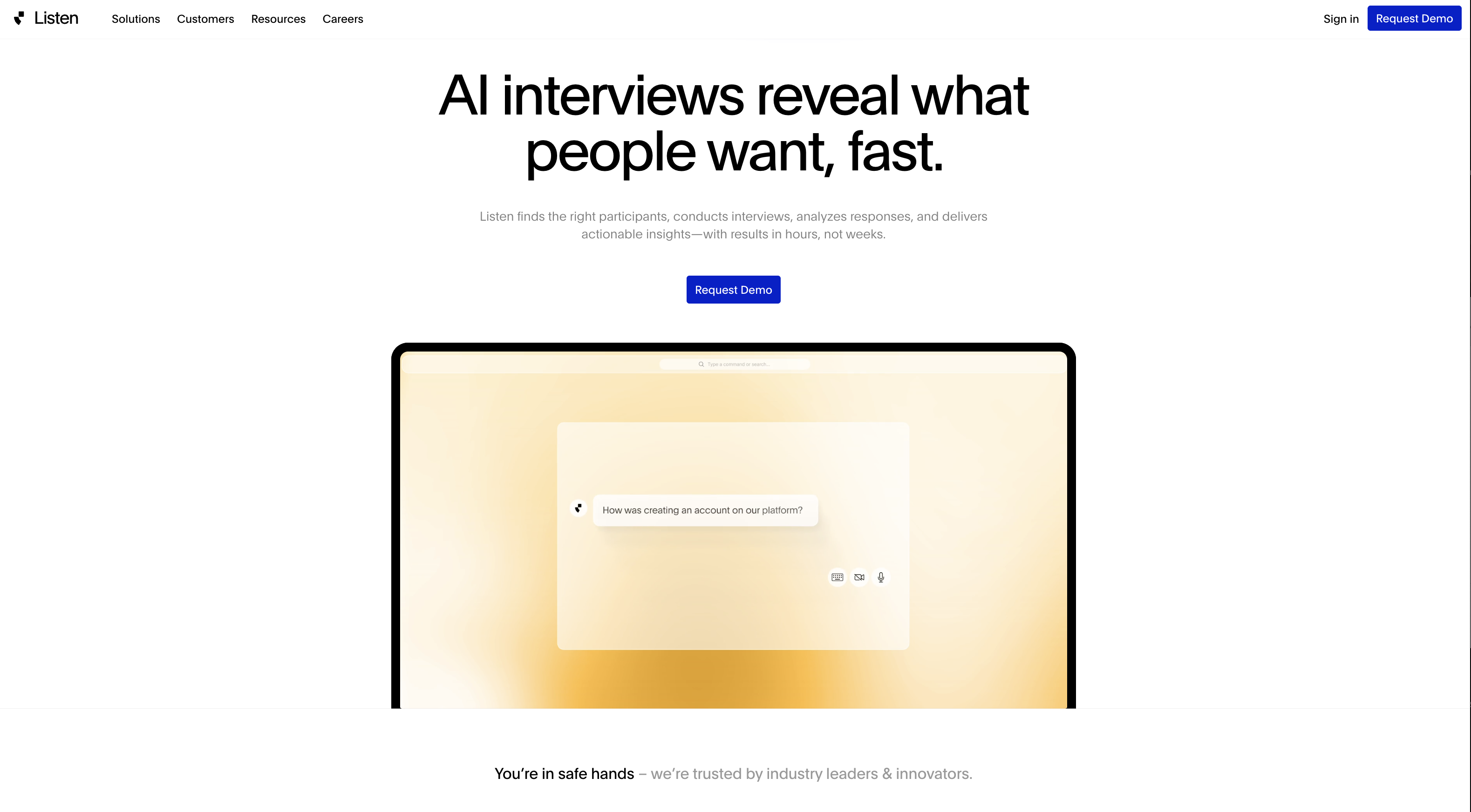According to our 2024 State of User Research report, over half (56%) of UX researchers say they’re using AI to support some aspect of their work—a 36% increase from 2023. Whether you’re firmly using AI for research or part of the 28% who said they’re planning to try it, knowing what’s available goes a long way.
In this article, we’ll dig into AI tools and platforms that you can use to support some or all of your research process. We organize the tools into six categories:
- Generation or ideation (e.g., creating prototypes)
- Testing
- Moderation
- Analysis or synthesis
- Repository building
- “All-in-ones”
For each tool, we share a link, brief description of what it does, and pricing information.
Editor’s note: Although this article is all about AI, a human—Ben Wiedmaier—compiled it and wrote everything you see below. He used forums, desk research, and his own experience to curate the list of tools. Asterisks (*) by tools indicate an integration with User Interviews.
✨ Read our Early Adopter's Guide to AI Moderation in UX Research
The 3 kinds of AI tools used for UX research
Compiling a list of all AI tools would not only be impossible, it wouldn’t be very useful. That’s why we’ve focused on one category of AI tools and technology: those specifically designed for research. These are purpose-built with the kinds of data, workflows, and needs of user/UX/product/design researchers (and those who support them) in mind.
There are two other kinds of AI tools worth mentioning, although we don’t cover them here:
All-purpose AI tools
These are what most people think of when they read “AI tools.” These tools use AI technology to support a range of use cases, some of which might apply to researchers.
These include generative large-language models like ChatGPT and Claude, as well as use case-specific tools like those for transcription and note taking (which are used by sales professionals and researchers alike).
AI features in other tools
In addition to standalone AI tools, there are more and more existing platforms adding AI features to them. These features support many of the needs as others explored here, like summarization, theming, or query-based discovery. Of course, you’ll need to already be using the larger tool or platform to get the most value out of these features.
Notably examples include Figma’s Figjam AI and Notion’s AI summary tool (among many, many others).
Because we think AI is going to help a lot of researchers, people-who-do-research, and those who support them, we’ve focused on this particular category for our analysis.
AI tools for generation or ideation
Consensus

Consensus is an AI search engine for research, offering features like automatic summaries, quality ratings, relevance suggestions, and customizable filters. Pricing ranges from $0 to $12.99/month, based on seats, searches needed, and other features.
Elicit

Elicit focuses on pre-fieldwork tasks, such as desk research, literature summaries, data extraction from existing work, and cross-project synthesis. Pricing ranges from $0 to $49/month based on the number of PDFs analyzed.
Listen

Listen supports qualitative research conducted and analyzed by AI, replacing manual research methods with AI-moderated customer interviews. Demos and pricing available by request.
Merlin

Merlin is a chat-based AI browser extension specializing in research summaries, brief generation, and other pre-fieldwork discovery tasks. It uses several LLMs at once. Pricing ranges from $0 to $29/month, based on the number of queries and customizations needed.
QoQo

QoQo is a Figma plugin focused on helping UX design teams at the early stages of research, generating “cards” to help build out personas, user needs, or even concepts/prototypes. Pricing is offered per month ($7) or annually ($48); both for one user and unlimited access.
Uizard

Uizard creates wireframes and prototypes for mobile or desktop experiences using text-based prompts. Features include Miro integration, template creation, and journeys. Pricing ranges from $0 to $39/month (for annual subscriptions), based on the number of AI generations used.
Userdoc

Userdoc supports project scoping, including user definition, journeys, goals, and more. Features include versioning, collaboration, compliance and audits, and integrations. Pricing ranges from $99 to $249/month, based on seats and number of projects.
UX Pilot

UX Pilot is a Figma plugin offering prompt-based wireframe creation, text-to-insight, design review, and user interview guide generation. Pricing is $9/month, or free with feature gates.
Report: Read how 1,000 UXRs use AI.
AI tools for testing
Attention Insight

Attention Insight reviews concepts, supporting heatmaps, eye tracking, and focus maps. Features include integrations with prototyping tools, A/B testing, and contextual environments. Pricing ranges from $31 to $324/month, based on analysis credits and seats (with other gated features).
Clueify

Clueify uses AI to offer feedback on designs and concepts, offering heatmaps, gazeplots, and focus maps, for both mobile and desktop-based experiences. Pricing ranges from $25 to $79/month based on seats and number of analyses needed.
AI tools for moderation
Heard

Heard offers AI moderation, including customizable follow-ups, thematic analysis, and summary reporting. It also offers AI interview guide suggestions and customizable exports. Early access is available via a form fill.
Outset

Outset offers AI moderation, including customizations around when to probe more deeply. It also offers transcription, stimulus sharing, and automatic analysis and synthesis. Pricing is not publicly available as of this writing.
AI tools for analysis or synthesis
Collectif

Collectif is marketed for product discovery and continuous insights, offering integrations with feedback and support platforms, analyzing and organizing open-ended data. Collectif is currently in Beta.
CoNote

CoNote is a platform focused on analysis of open-ended and unstructured data, such as interviews. It offers transcription, video clip creation, themes generation, and deliverables. Pricing ranges from $0 to $195/month, based on seats and amount of data analyzed.
FindOurView

FindOurView analyzes text-based data, automatically evaluating hypotheses for validation, summarizing results, and sharing in team communications channels via integrations. Pricing is not publicly available as of this writing.
Innerview

Innerview offers multi-language transcription and analysis of video data, offering highlighting, search, segmentation, and query-based insight surfacing. Pricing is not publicly available as of this writing.
Watch: Two AI UX researchers answer your questions.
Insight7

Insight7 analyzes video, audio, and text data for themes, report and journey map creation. It also offers recording, transcription, and query-based data engagement features. Pricing ranges from $19 to $299/month, based on seats and amount of data analyzed.
InsightLab

InsightLab analyzes and makes searchable audio, video, and text-based data. It includes query-based analysis and includes integrations with some survey and feedback tools. Pricing ranges $15 to $49/month, based on the amount of data analyzed.
Kraftful

Kraftful analyzes open-ended data. It offers query-based features, sentiment analysis, project-based organization, and integrations with customer feedback and support tools. Pricing ranges from $15 to $400/month, based on words analyzed, seats, and other features.
Olvy

Olvy analyzes data from support, feedback, and research streams in a single platform. Features include query-based interaction, customizable tagging, and API integrations. Pricing ranges from $0 to $300/month, based on seats, data analyzed, and integrations.
Reveal

Reveal helps analyze and synthesize open-ended data. It uses an upload-then-ask format, where data are added to its platform and queries are used to organize and surface findings. Pricing includes pay-as-you-go starting at $10/session or $99/month.
Viable

Viable aggregates and analyzes customer feedback and support data, offering query-based interactions to analyze trends, tag, and synthesize. Features include integrations and an API. Pricing ranges from $600 to $1,000/month based on pieces of feedback analyzed.
Yabble

Yabble supports multiple phases of the analysis process, including data creation (vai “virtual audiences”), thematic and summary synthesis, and query-based data conversations. Pricing ranges from $8,900 to $80,000/year, based on “credits” consumed.
Related Reading: Five ways AI will help UXRs.
AI tools for building a repository
Looppanel*

Looppanel offers analysis, auto-tagging, querying of open-ended and video data. Features include built-in sentiment analysis, affinity mapping, transcription, auto note-taking, and insight report building and sharing. Pricing ranges from $27 to $325/month (with annual subscription), based on transcription hours.
Marvin*

Marvin transcribes, records, stores, analyzes, and organizes open-ended data. It also supports data upload and feedback tool integration. Features include collaborative note-taking, visual search, and highlight creation and sharing. Pricing ranges from $0 to $100/month/user, with some feature gating across plans.
Notably

Notably focuses on synthesis of data, with analysis, summaries, transcription, auto-tagging, and collaboration tools. Features include participant tracking, AI templates, and branding. Pricing ranges from $50 to $400/month based on viewers and transcription hours.
User Evaluation

User Evaluation uses AI to transcribe, store, organize, analyze, and make searchable video and open-ended data. Features include report generation, sentiment analysis, and clip creation. Pricing ranges from $0 to $99/month, based on projects, seats, and transcription hours (with some feature gating).
Listen: How to safely analyze data using AI.
“All-in-one” AI tools
Remesh

Remesh offers AI supported and led research project development, recruitment, fieldwork, and text data analysis. Features include survey imports, sentiment analysis, and clustering. Pricing is not publicly available as of this writing.
ResearchGOAT

ResearchGOAT’s platform offers plan and discussion guide creation (based on prompts), recruitment management, AI moderation, and analysis readouts from interviews. Pricing is free for the first 360 interview minutes, then $1/minute after 360 per month.
How to choose an AI tool for UX research
Although adding a new tool can be exciting, it should involve a careful review, analysis, and evaluation process, especially if it’s going to impact your delivery dates, user data, or product decisions. Checking with colleagues and even your engineering or IT departments could be a good first step.
Case study: How a UX researcher uses AI in their workflow.
After that, here are four considerations when choosing an AI tool for UX research:
1. Free trials
Most of the tools on this list offer them, which is a perfect way to test their claims, the accuracy of their AI, and how feasible it is to use it on a regular basis for your work.
2. Integrations
We don’t love all-in-ones because they can isolate data from others or make it difficult to collaborate. Similarly, evaluate how well a tool “plays” with others. Does it require downloads and exports to talk to other tools or does it offer an integration or API? If you plan to use a tool longer-term, this is very important.
3. Privacy and security
If you plan to introduce your user’s data into an algorithm, it’s critical that you understand who “owns” the model, can access the data, and what access/deletion controls you have. Check the tool’s FAQ/support docs for details.
4. Workflow inventory
Some AI tools are just plain fun. Generative AI can feel like magic…but is that magic actually helping you get more, better work done? Conducting a quick workflow analysis, using a 2x2 of “time needed” and “importance” to evaluate where a tool might helpfully speed things up, freeing you to tackle the tasks that both take longer and are important.
The fastest way to recruit for research: With User Interviews, it's simple to run high-quality research with your target audience. It's the only tool that lets you source, screen, track, and pay participants from your own panel, or from our network. Book a demo.



















